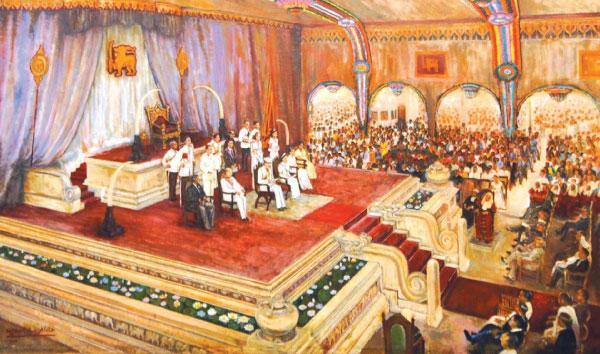
Our beautiful island nation gained Independence after 132 years of British rule on February 4, 1948 and celebrations were held from February 4-17, 1948. February 4 was declared a national holiday.
Early morning on February 4, 1948 temple and church bells pealed and the national flag was hoisted along with the British flag at the Old Parliament. Good wishes were showered on Premier D. S. Senanayake from all over the world including one from British Premier Clement Attlee.

At 7.30 a.m. on this day was the swearing-in of the first Governor General of Independent Ceylon at Queen’s House, (present President’s House) Fort, Colombo. It was Sir Henry Monck Mason Moore, the last Governor of Colonial Ceylon who took oaths as the Governor Genera before Patrick Gordon Walker, Under Secretary of State of the British Commonwealth Relations Office. Prime Minister D. S. Senanyake and other dignitaries attended the event.
Celebrations were held islandwide and the national flag was flown at Temple Trees, other government buildings, commercial and private residences.
Religious ceremonies were held at places of worship of all religions. Pirith chanting was held at the Kelaniya Temple to coincide with the Governor General’s swearing in and this was broadcast on radio.
Entrance to the Zoo at Dehiwela was free and it is said that 350 people entered the zoo per minute and that by 11 a m 8,000 people had visited the zoo.
The Prime Minister and the Governor General addressed the nation and the Prime Minister planted a mango plant at the Polwatte Temple in Colombo to mark the great event.
The most important event of the Independence celebrations took place on February 10, 1948 at the Independence Square. This was the first session of the maiden Parliament of Independent Ceylon with the Duke of Gloucester representing the King of England George VI (father of Queen Elizabeth the Second and brother of the Duke of Gloucester). The Duchess of Gloucester accompanied him.
A large, temporary hall was needed to house the large number of invitees to the event and a suggestion was made that a World War II relic, an old aircraft hangar be converted to a temporary Ceremonial Hall. This was enthusiastically accepted and an engineer at the then Public Works Department, Hapugoda Rankothge Premaratne (H.R.) was entrusted with the task.
 |
| Ceylon's First Prime Minister D. S. Senanayake hoisting the national flag on February 4, 1948 |
Converting the high roofed hangar to a Ceremonial Hall was a tremendous task.The hall was done in an architectural style similar to the Magul Maduwa (Ceremonial Hall main entrance) in Kandy. The entrance had three arches and was decorated with a Makara Thorana (Dragon Pandal). Between the columns in the hall were the traditional ralipalams. The columns were decorated with traditional designs such as the lotus and the panchanari knot. Traditional Sinhala Lion banners, Nandi flags from Jaffna and cultural motifs of the Muslim community were also used in the décor.
Approximately 20,000 yards of white cloth and almost 20,000 yards of coloured paper were used while around 9,000 yards of jute hessian was used to cover the ceiling.
Veteran journalist and editor, D. B. Dhanapala in his book 'Among Those Present', states: 'H. R. Premaratne had converted an enormous, ugly aeroplane hangar left by the RAF at Torrington Square into a veritable Palace of Pageantry.’
H.R. Premaratne was also an artist and his painting of this event is on display in the President’s House collection of art.
Above the dais prepared for the Duke and Duchess was another dais on which stood the throne of the last King of Kandy Sri Wickrama Rajasinghe.
When the Duke and Duchess arrived the King’s crown and sword were placed in front of the throne by the leaders of the Senate and Parliament.
On arrival at Independence Square the Duke and Duchess were welcomed by the Governor General and Prime Minister. After a twenty one gun salute the Prime Minister hoisted the Lion flag.
The Parliament was formally opened and the proceedings took place.
On February 13 the Duke and Duchess attended a ceremony at the Magul Maduwa in Kandy and the Duke hoisted the national flag from the Paththirippuwa and declared Ceylon to be an independent state.
In 1972 Sri Lanka was declared a Republic by the then Government led by Prime Minister Sirimavo Ratwatte Dias Bandaranaike.
